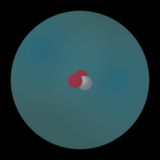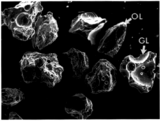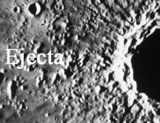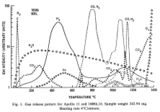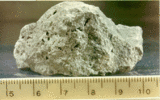Difference between revisions of "Featured Articles"
(Merging Historical Lunarpedia Category into Maintenance) |
|||
| (One intermediate revision by one other user not shown) | |||
| Line 1: | Line 1: | ||
==Currently Featured Article== | ==Currently Featured Article== | ||
| + | ===<!--[[Image:red_ring.png|15px|left]]-->Featured article: [[Eddy Current Brake to Orbit]] | 24 October 2019=== | ||
| + | [[File:Eddy current concept.png|160px|left]] | ||
| + | This device is the central feature of a spacecraft carrier that receives spacecraft into orbit as an aircraft carrier receives aircraft that land on its deck. It works by having a long slotted aluminum tube in orbit and having the shuttle vehicle that is launched to orbital altitude enter this slot while the tube is moving by at orbital speed. The shuttle only needs to reach orbital altitude to enter the eddy current brake tube. That can be 10 kilometers on Luna at the perilune, an altitude that can be reached with 188 meters per second mission delta v, including gravity loss, a few seconds maneuvering fuel, and a small safety margin. Magnetic flux from permanent magnets deployed by the shuttle is directed at the walls of the tube causing a repulsive force and a retarding force.<ref>[http://en.wikipedia.org/wiki/Eddy_current_brake ''Eddy current brake'' at Wikipedia]</ref><ref>[https://en.wikipedia.org/wiki/Inductrack ''Inductrack'' at Wikipedia]</ref> By reducing the speed of the shuttle relative to the orbiting aluminum tube, the shuttle is brought up to near orbital speed. Since eddy current braking loses effectiveness at low relative speeds, friction braking is used to give the shuttle the last 18 meters per second to reach orbital speed and match velocity with the aluminum tube. During all the time that the relative speed of the shuttle and the aluminum tube is greater than 18 meters per second, there is no contact between the material of the shuttle and the material of the aluminum tube. ...([[Eddy Current Brake to Orbit|read more]]) | ||
| + | |||
| + | |||
| + | |||
| + | ==Previously Featured Articles== | ||
| + | ===<!--[[Image:red_ring.png|15px|left]]-->Featured article: [[Helium]]=== | ||
| + | [[File:He-3 T620 01.svg|160px|left]] | ||
| + | '''Helium''' is a component of the solar wind, and hence is one of the volatiles found (in parts per million level) in Lunar regolith. It is a Noble gas in group 18 and is the second element in the Periodic Table of the Elements. This element has two stable isotopes: 3 and 4. | ||
| + | |||
| + | Helium 3 is a rare isotope of the element Helium, consisting of a nucleus with two protons and one neutron. | ||
| + | |||
| + | It has been proposed that <sup>3</sup>He might be a possible fuel for a [[Nuclear Fusion]] reactor to produce energy using the thermo-nuclear reaction (Deuterium-Helium-3): | ||
| + | |||
| + | <sup>2</sup>H + <sup>3</sup>He --> <sup>4</sup>He + <sup>1</sup>H<sup>+</sup> | ||
| + | |||
| + | This reaction has the advantage over the more-commonly proposed Deuterium-Tritium fusion reaction...([[Helium|read more]]) | ||
| + | |||
===<!--[[Image:red_ring.png|15px|left]]-->Featured Article: [[JSC-1]] | 20 September 2011=== | ===<!--[[Image:red_ring.png|15px|left]]-->Featured Article: [[JSC-1]] | 20 September 2011=== | ||
[[Image:EIC050-2.GIF|160px|left]] JSC-1, a lunar soil simulant, was developed and characterized under the auspices of the NASA Johnson Space Center. This simulant was produced in large quantities to satisfy the requirements of a variety of scientific and engineering investigations. JSC-1 is derived from volcanic ash of basaltic composition, which has been ground, sized, and placed into storage. The simulant's chemical composition, mineralogy, particle size distribution, specific gravity, angle of internal friction, and cohesion have been characterized and fall within the ranges of lunar mare soil samples. ...([[JSC-1|read more]]) | [[Image:EIC050-2.GIF|160px|left]] JSC-1, a lunar soil simulant, was developed and characterized under the auspices of the NASA Johnson Space Center. This simulant was produced in large quantities to satisfy the requirements of a variety of scientific and engineering investigations. JSC-1 is derived from volcanic ash of basaltic composition, which has been ground, sized, and placed into storage. The simulant's chemical composition, mineralogy, particle size distribution, specific gravity, angle of internal friction, and cohesion have been characterized and fall within the ranges of lunar mare soil samples. ...([[JSC-1|read more]]) | ||
| − | |||
| − | |||
===<!--[[Image:red_ring.png|15px|left]]-->Featured Article: [[Moon Zoo]] | 11 May 2010=== | ===<!--[[Image:red_ring.png|15px|left]]-->Featured Article: [[Moon Zoo]] | 11 May 2010=== | ||
[[Image:Moon Zoo Logo.gif|160px|left]] Moon Zoo is a crowdsourcing project from the Zooniverse community that uses images from the Lunar Reconnaissance Orbiter. | [[Image:Moon Zoo Logo.gif|160px|left]] Moon Zoo is a crowdsourcing project from the Zooniverse community that uses images from the Lunar Reconnaissance Orbiter. | ||
Latest revision as of 03:45, 24 October 2019
Contents
- 1 Currently Featured Article
- 2 Previously Featured Articles
- 2.1 Featured article: Helium
- 2.2 Featured Article: JSC-1 | 20 September 2011
- 2.3 Featured Article: Moon Zoo | 11 May 2010
- 2.4 Featured article: Cratering on the Moon | 02 November 2008
- 2.5 Featured Article: Volatiles | 05 August 2008
- 2.6 Featured Article: Sintered Regolith | 29 June 2008
- 2.7 Featured Article: KREEP | 14 May 2008
Currently Featured Article
Featured article: Eddy Current Brake to Orbit | 24 October 2019
This device is the central feature of a spacecraft carrier that receives spacecraft into orbit as an aircraft carrier receives aircraft that land on its deck. It works by having a long slotted aluminum tube in orbit and having the shuttle vehicle that is launched to orbital altitude enter this slot while the tube is moving by at orbital speed. The shuttle only needs to reach orbital altitude to enter the eddy current brake tube. That can be 10 kilometers on Luna at the perilune, an altitude that can be reached with 188 meters per second mission delta v, including gravity loss, a few seconds maneuvering fuel, and a small safety margin. Magnetic flux from permanent magnets deployed by the shuttle is directed at the walls of the tube causing a repulsive force and a retarding force.[1][2] By reducing the speed of the shuttle relative to the orbiting aluminum tube, the shuttle is brought up to near orbital speed. Since eddy current braking loses effectiveness at low relative speeds, friction braking is used to give the shuttle the last 18 meters per second to reach orbital speed and match velocity with the aluminum tube. During all the time that the relative speed of the shuttle and the aluminum tube is greater than 18 meters per second, there is no contact between the material of the shuttle and the material of the aluminum tube. ...(read more)
Previously Featured Articles
Featured article: Helium
Helium is a component of the solar wind, and hence is one of the volatiles found (in parts per million level) in Lunar regolith. It is a Noble gas in group 18 and is the second element in the Periodic Table of the Elements. This element has two stable isotopes: 3 and 4.
Helium 3 is a rare isotope of the element Helium, consisting of a nucleus with two protons and one neutron.
It has been proposed that 3He might be a possible fuel for a Nuclear Fusion reactor to produce energy using the thermo-nuclear reaction (Deuterium-Helium-3):
2H + 3He --> 4He + 1H+
This reaction has the advantage over the more-commonly proposed Deuterium-Tritium fusion reaction...(read more)
Featured Article: JSC-1 | 20 September 2011
JSC-1, a lunar soil simulant, was developed and characterized under the auspices of the NASA Johnson Space Center. This simulant was produced in large quantities to satisfy the requirements of a variety of scientific and engineering investigations. JSC-1 is derived from volcanic ash of basaltic composition, which has been ground, sized, and placed into storage. The simulant's chemical composition, mineralogy, particle size distribution, specific gravity, angle of internal friction, and cohesion have been characterized and fall within the ranges of lunar mare soil samples. ...(read more)
Featured Article: Moon Zoo | 11 May 2010
Moon Zoo is a crowdsourcing project from the Zooniverse community that uses images from the Lunar Reconnaissance Orbiter.
Activities include counting craters, noting blocky craters, and checking relative differences between boulder-producing craters, and...(read more)
Featured article: Cratering on the Moon | 02 November 2008
Craters cover the surface of the moon and are the result of hyper-velocity impacts by meteorites. The velocity of meteorites upon impact varies, but is generally between 10 and 40 km/sec. This number is a combination of the ‘approach velocity’ and the ‘escape velocity.’ The approach velocity of objects refers to the velocity of the object with respect to the moon. This varies with the type of object (for example, long period comets generally have a higher approach velocity than short period comets) and the direction with which it approaches the moon (for example, if it approaching the moon ‘head on,’ it will have a higher approach velocity than...(read more)
Featured Article: Volatiles | 05 August 2008
The primary resource of value to humans on the Moon is the volatile components found in the regolith. These are all the components that are gases at room temperature. Most of the volatiles have been deposited in the top layers of the Moon's surface by the solar wind over geologic time. A notable exception to this is Argon. the concentration of Argon in lunar soil is much higher than found in the solar wind, so must come from a different source. Especially, the isotope Argon-40. It is presently believed that the Argon-40 comes from radioactive decay of Potassium and/or Krypton deep within the lunar mantle or core(read more)
Featured Article: Sintered Regolith | 29 June 2008
Sintered regolith falls into the category of ceramic materials as sintering is the process most common to ceramics. When bricks are made from clay on Earth, first the bricks are heated long enough and hot enough to drive out the water. Then the heating is increased to cause partial melting or vitrification which results in the edges of adjacent grains being bonded together once they have cooled. The unmelted particles provide a stable shape and size during the process which involves some shrinkage and a decrease in porosity.
Experiments in radiant heating of regolith simulant have been carried(read more)
Featured Article: KREEP | 14 May 2008
KREEP is an acronym used in geochemistry to represent a mixture of K-potassium, REE-rare earth elements, and P-phosphorus. It is not only the main source of these elements on the moon, but also many other trace elements such as uranium, thorium, fluorine, chlorine, and zirconium.
...
So to get alloy ingredients for workable metals, nutrients for agriculture, industrial reagents and much more, special concentrations such as ilmenite and KREEP will play a vital role." - Peter Kokh

